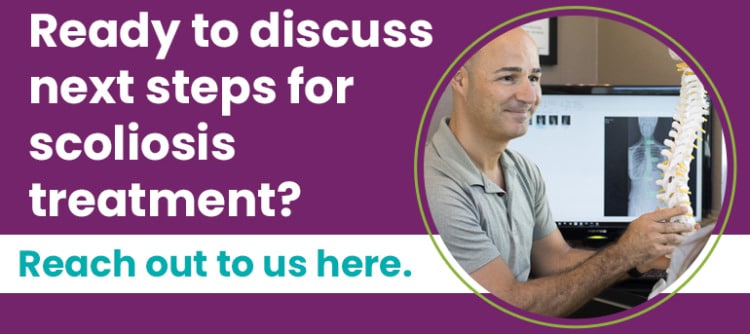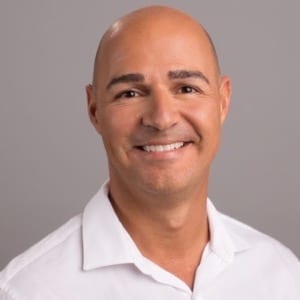Spinal Braces for Scoliosis: Types and Effectiveness
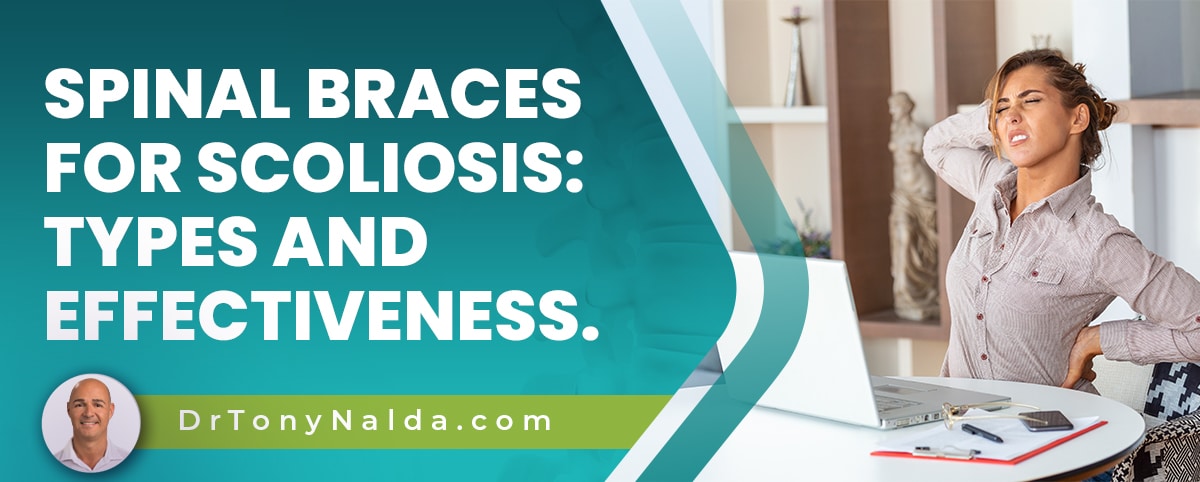
While no single facet of scoliosis treatment can impact conditions on every level as is necessary for true correction, with integration, multiple different types of treatment are applied. Conservative treatment favors the ultra-corrective power of the ScoliBrace®.
There are different types of scoliosis braces from traditional to corrective, and different designs can produce different results. From a traditional Boston brace to the ultra-corrective ScoliBrace, bracing can focus on stopping progression or working towards corrective results.
Just as there are different treatment approaches to scoliosis, there are different brace types that offer different results.
Table of Contents
Bracing and Scoliosis
Scoliosis is a highly-prevalent spinal condition that warrants awareness. The Scoliosis Research Society has current estimates at close to seven million people currently living in the United States alone, and as the leading spinal condition among school-aged children, regular screening for children is recommended.
Risk factors for scoliosis include gender, age, and family history.
Scoliosis is a complex spinal condition that causes the spine to bend unnaturally to the side and twist, and there are many different ways to respond with treatment.
It is also important to understand that scoliosis is a progressive condition, meaning its nature is to get worse over time, and progression is triggered by growth.
There are different types of scoliosis and all age groups are affected, but the age group the most at risk for rapid progression are adolescents; adolescent idiopathic scoliosis is the condition's most prevalent type overall.
So when treating adolescents, the focus is on how to counteract the progressive nature despite the constant trigger of growth occurring.
Growing spines are more malleable as the condition is not yet compressive, which happens when skeletal maturity has been reached, so bracing is a regular facet of childhood scoliosis treatment and can deliver impressive results.
A scoliosis brace is an orthotic device that's worn snugly around the torso to prevent the spine from becoming more unnaturally bent and twisted and helps to correct the curve.
But it's important to understand that there are different braces to choose from and not all are created equal.
Traditional Scoliosis Braces
There are two main treatment approaches to scoliosis: traditional and conservative.
Traditional treatment was the dominant choice for many years, but that doesn't mean it was the best or only treatment option available.
Traditional treatment commonly recommends watching and waiting for cases of mild scoliosis, but this is when conditions will be at their most responsive; watching and waiting and periodic assessments to check for progression can mean growth spurts occurring and curves progressing unimpeded.
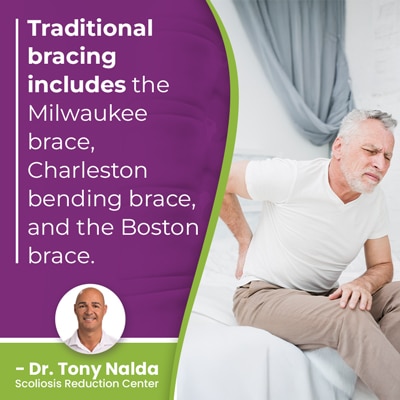 Traditional bracing includes the Milwaukee brace, Charleston bending brace, and the Boston brace.
Traditional bracing includes the Milwaukee brace, Charleston bending brace, and the Boston brace.
The Boston brace is the most commonly used traditional brace, so let's explore its shortcomings.
Because scoliosis causes the spine to bend unnaturally to the side, but also twist, the condition is 3-dimensional, and this means it has to be treated as a 3-dimensional condition, but the Boston is a 2-dimensional brace so does nothing to address the condition's rotational component: limiting its potential efficacy.
The Boston brace was designed in the 1970's and its design has changed little over the years. The brace does involve some measurements, but it's mass produced so isn't fully customized.
The Boston is bulky and uncomfortable to wear, and the main challenge to scoliosis bracing isn't efficacy; it's compliance.
Unless a brace is worn precisely as prescribed, its efficacy is limited, and when we're talking about adolescents who just want to fit in with their peers, this is a challenge.
The Boston brace also works via a 3-point pressure system with pads placed inside the brace putting pressure on particular areas of the curve, but this type of pressure involves squeezing the spine into a straighter alignment, and this can weaken an already vulnerable spine.
The evolution of corrective bracing changed the face of scoliosis bracing and reflects what we've learned about scoliosis and bracing efficacy over the years.
Modern Corrective Bracing
The modern corrective ScoliBrace® represents the culmination of what we've learned about bracing over the years.
Here at the Scoliosis Reduction Center® bracing is a facet of treatment that's complemented by several other scoliosis-specific treatment disciplines
Our brace of choice, for its corrective potential, is the ultra-corrective ScoliBrace because it addresses the condition's true 3-dimensional nature, pushes the spine into a corrective position instead of squeezing it excessively, and is fully customized to suit a patient's body and curve type for better rates of compliance.
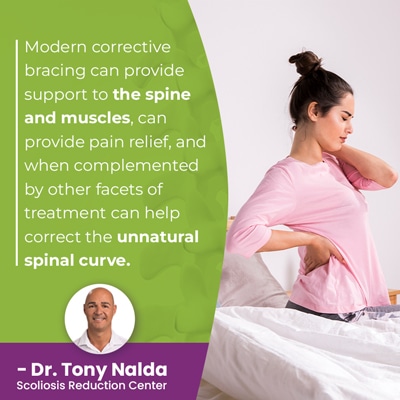 Modern corrective bracing can provide support to the spine and muscles, can provide pain relief, and when complemented by other facets of treatment, can help correct the unnatural spinal curve.
Modern corrective bracing can provide support to the spine and muscles, can provide pain relief, and when complemented by other facets of treatment, can help correct the unnatural spinal curve.
The ScoliBrace® is designed based on a number of images and scans using state of the art equipment, and this ensures that braces are comfortable and easier to conceal under clothes.
In many cases of adolescent idiopathic scoliosis, braces are prescribed for full-time wear, so how comfortable they are is a key factor; full-time wear can mean up to 23 hours a day for up to five years, or when skeletal maturity has been reached.
There are also different types of braces that are worn strictly at nighttime, and the idea of these is that the spine can be placed in an over-corrective position during sleep because the brace doesn't have to allow for movement.
Conservative Treatment and Scoliosis Bracing
Here at the Center, a conservative non-surgical treatment approach is applied, and this often includes the ScoliBrace®.
Conservative treatment is also integrative so combines the power of multiple different types of treatment for the best results and so conditions can be impacted on every level.
No brace on its own can fully correct a scoliosis, regardless of its efficacy; other treatments need to be applied, and in particular, treatment that addresses the condition's underlying structural nature.
Conservative treatment is chiropractic-centered, so a number of chiropractic techniques and adjustments are applied to work towards adjusting the position of the curve's most-tilted vertebrae back into alignment with the rest of the spine.
In addition, physical therapy and scoliosis exercises are applied to improve the spine's surrounding muscle balance and strength so the spine has more support and stability.
Physical therapy can also help improve posture for better body positioning and brain-body communication.
Corrective bracing complements these other disciplines as they work together to impact conditions on every level, but only a corrective brace will also address the condition's rotational component, be fully customized, and push the spine instead of squeezing it excessively.
As a progressive condition, treatment is about how best to manage an ongoing condition for the best quality of life, and this involves rehabilitation to further heal and stabilize the spine.
A healthy spine is key to a healthy body; it helps us stand upright, move flexibly, protect important organs, and works with the brain to form the central nervous system.
Bracing and Adult Scoliosis
As mentioned, bracing is more commonly used for its corrective potential in childhood scoliosis treatment, and while bracing can also be used in the treatment of adult scoliosis, it's used with different goals in mind.
In childhood scoliosis, the focus of bracing is to augment corrective results, and in adult scoliosis because the risk of rapid progression is not as extreme, the focus is on short-term pain relief and increasing the spine's stability during treatment.
Conclusion
A healthy spine needs to have its natural curves in place, and this means at each of the spine's main sections, the curve isn't excessive or under-pronounced, and the spine's vertebrae are aligned in a straight and neutral position as they should be.
If the spine develops an unhealthy curve, its biomechanics are disrupted, and this can cause functional deficits, postural and movement changes, and pain.
Traditional bracing like the Boston brace is limited because of its design: not addressing the condition's rotational component, squeezing the spine excessively, and not fully customizing the brace for better compliance.
A corrective brace that's custom molded to a patient's body is going to be one that's more comfortable, easily concealable under clothes, and has corrective potential.
Traditional bracing doesn't address the condition's rotational component so is limited in its potential efficacy.
While no brace on its own is enough to correct scoliosis, when a corrective brace is combined with a proactive conservative treatment approach, bracing can be a valuable facet of treatment, particularly for childhood scoliosis.
Patients need to understand that just as there are different treatment approaches that offer different types of results, different bracing options also affect the spine differently.
While traditional bracing works by squeezing the spine into a straighter alignment, corrective bracing works by pushing it into a healthier position, which is a gentler approach.
And as corrective bracing is part of a proactive conservative approach, scoliosis can be impacted on every level with a multi-faceted non-surgical treatment approach.
Dr. Tony Nalda
DOCTOR OF CHIROPRACTIC
After receiving an undergraduate degree in psychology and his Doctorate of Chiropractic from Life University, Dr. Nalda settled in Celebration, Florida and proceeded to build one of Central Florida’s most successful chiropractic clinics.
His experience with patients suffering from scoliosis, and the confusion and frustration they faced, led him to seek a specialty in scoliosis care. In 2006 he completed his Intensive Care Certification from CLEAR Institute, a leading scoliosis educational and certification center.
About Dr. Tony Nalda
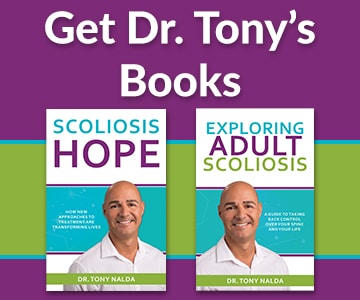 Ready to explore scoliosis treatment? Contact Us Now
Ready to explore scoliosis treatment? Contact Us Now